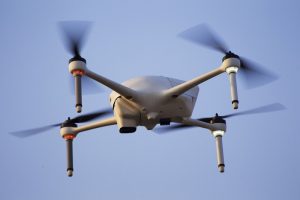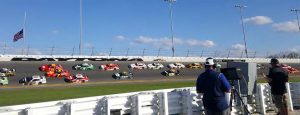White Paper: Rethinking Drone Usage on Live Broadcasts
Story Highlights
Drones possess the potential to change the look of a sports broadcast. When they first came on the scene, the excitement around this new technology seemed to indicate they would be flying around at major sports events in no time. Their potential to capture dynamic images for millions of viewers seemed endless in those early days, and yet broadcasters have had a difficult time integrating them into their live sports productions.
Despite improvements in flight times, gimbals, and obstacle-avoidance systems, drones have added little to no value to live sports broadcasts. Rather, drones are used mostly for preproduced content for packages and teases. They have become costly additions to live productions, and broadcasters require more-substantial contributions from them if they are going to be used regularly on shows other than the highest-rated A shows and mega events, the only productions capable of absorbing the cost of a drone for a few beauty shots. Broadcasters have struggled to integrate drones into their live sports productions, but they can change that trend with policy and production changes that could position motorsports broadcasts as the ideal platform for drones.
 Over the past five years, broadcasters’ attempts at integrating drones into their live productions have been hindered by safety concerns, technical limitations, and the nature of live production generally. Concerns about athlete and spectator safety have resulted in extremely small fly spaces that have effectively taken away drones’ ability to create dynamic moving images for a broadcast. Technically, noise and batteries have further limited their use. Drones create enough noise to keep them from flying close to athletes during play in most sports, and their batteries provide only about 15 minutes of flight time when sports broadcasts last several hours.
Over the past five years, broadcasters’ attempts at integrating drones into their live productions have been hindered by safety concerns, technical limitations, and the nature of live production generally. Concerns about athlete and spectator safety have resulted in extremely small fly spaces that have effectively taken away drones’ ability to create dynamic moving images for a broadcast. Technically, noise and batteries have further limited their use. Drones create enough noise to keep them from flying close to athletes during play in most sports, and their batteries provide only about 15 minutes of flight time when sports broadcasts last several hours.
Which leads to another limitation: the nature of live broadcasts generally. Live productions are a delicate balance of planning, timing, and collaborative improvisation. Successful technologies must be reliable so the production crew can use them the second they are needed. A drone’s frequent battery changes make it difficult to anticipate when it will be available for use. With all these limitations, broadcasters are still searching for the best method of integrating them into their live sports broadcasts.
Made for Motorsports
Looking at which sports are suited to using drones during a live broadcast, we find that motorsports broadcasts are uniquely positioned to take advantage of a drone’s capabilities and work around its limitations.
To begin with, noise is a non-issue in motorsports because the vehicles are loud. Drones can fly close to their subjects without being distracting. In addition, racetrack surfaces offer large, obstacle-free fly spaces free of crowds; a drone crashing on a racetrack could never injure a spectator.
In addition, every racer wears protective gear from head to toe, so risks of serious injury are lessened should a drone run into them or their vehicle. This is especially true in closed-cockpit auto racing, where the drivers are fully enclosed by the vehicles and the cars regularly deflect debris from other cars traveling at 200 mph.
And motorsports have organized crews of trained professionals capable of quickly cleaning up a crashed drone. If a drone crashed on a track for any reason, safety workers could quickly pick it up and remove it.
With so many advantages, it seems clear that broadcasters should incorporate drones into their live motorsports productions, and they have. Unfortunately, as with other sports, drones have contributed little to the overall value of the live production. Looking at how drones have been used reveals why this has been the case.
In motorsports, broadcasters have been using drones to follow green-flag racing on the track. Although their intentions are on-point, their approach should be reevaluated because it has yet to yield the kind of dynamic shots one would expect from a drone. In fact, the images have been difficult to distinguish from those of the hard cameras.
As with other sports, safety concerns have kept the drone from flying over the track during green-flag racing. Though correct, this course of action has ultimately limited the drone’s fly space to just a small area in the infield or outside the track.
Compounding the problem, drones are difficult to pan with the cars. Broadcast drones are intended to provide stable images, and therefore they fly at only about 40 mph, which puts them at a severe disadvantage when asked to pan with vehicles racing by.
Moreover, getting a tally during green-flag racing is difficult for a non–line-cut, specialty camera like a drone. Three elements must come together at once: the director must anticipate using the camera, the drone has to be charged and in position, and the image has to fit with the overall narrative. Frequent battery changes, required production elements, and exciting racing on the track all work against a drone’s getting a creative tally during a broadcast, let alone changing the coverage in a meaningful way.
Limit Use to Cautions
It’s clear that drones haven’t worked out the way that broadcasters had hoped, so it’s time to consider the possibility that drones may be more effective if they are kept grounded during green-flag racing and used only during cautions.
This approach has the potential to effectively integrate drones into live sports broadcasts because it makes logical sense for several reasons.
First, it provides the director with a specific time frame for incorporating the drone into the broadcast. No more hit-or-miss attempts at getting the drone into the line-cut. When a caution happens, the director knows they can cut to the drone and it will be ready.
Second, it maximizes the drone’s flight time. Instead of wasting battery life waiting for random and infrequent tallies during green-flag racing, the caution period becomes a known quantity in which broadcasters get a full 15 minutes of usable coverage from the drone. An effective drone team should expect multiple, long tallies with every caution.
Third, it allows drones to fly safely over the track. During cautions, the risk of collateral damage from a drone crash is minimal because the vehicles on the pace lap are traveling at much slower speeds. This new approach opens the door for drones to create dynamic and engaging images that no other camera could provide, and it could drastically change how motorsports racing is covered.
With this new approach, when a caution happens, a drone could fly viewers out to the scene of the accident, providing close-up views and interesting angles of the crash site as safety workers arrive on the scene. This is exactly the kind of scenario that drones were made for: quick deployment over large areas to provide dynamic, informative images. For broadcasters, deploying drones during cautions means they can expect a substantial return on their investment as drones become the go-to camera during cautions. Holistically, the benefits of deploying drones during cautions far outweigh the struggles associated with using them during green-flag racing.
Moving the idea forward another step, broadcasters could use multiple drones to create even more engaging content. In this scenario, a race drone could fly alongside the vehicles on the pace lap while a broadcast drone, or two, could cover the clean-up efforts at crash sites. With multiple drones in use, cautions would become something viewers look forward to for more than just the replays of the accident.
Although the possibilities are exciting, this approach hinges on the ability of broadcasters to collaborate with racing leagues to establish safe and effective protocols for deploying drones during broadcasts. Together, broadcasters and race leagues can create a path for dynamic drone coverage, while still maintaining the same level of safety. Although the details will require some work, one thing is clear: the current restrictions on drones are stifling any possibility of their making substantial contributions to motorsports broadcasts. By extension, those same policies are stifling growth for both broadcasters and racing leagues.
In summary, drones have the potential to change sports broadcasts, and motorsports are the most likely place where that will happen. However, broadcasters need to make policy and production changes if they are to capitalize on the situation.
Specifically, broadcasters need to stop using drones during green-flag racing and instead, work with racing leagues to establish policies that allow drones to fly over designated portions of the tracks during cautions. Deploying drones during cautions provides production crews with a specific time for integrating them into the broadcast, maximizes the drone’s battery life, and allows the drone to create dynamic images that could keep viewers engaged.
All of this can be accomplished using today’s technology. If broadcasters make these changes, they can reshape motorsports coverage and demonstrate that, under the right conditions, drones can be valuable additions to live sports broadcasts.
This White Paper was originally published in the Fall Edition of the SVG SportsTech Journal. CLICK HERE to read the full publication.

